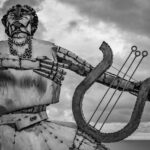Goibniu Fundamentals
Also referred to as Gaibhne, his name translates roughly to “Clever Smith,” pronounced in variations such as GIV-noo, GWIV-noo, or GIV-neh. Goibniu is celebrated in various oral traditions under names like Gobaun Seer and Goban Saor, the latter meaning “Goban the Builder,” along with Gavida Mac Samhthiann. He is found in the tales of the Tuatha De Danann, portrayed as Lon the Smith, who is notably depicted with a prosthetic arm he fashioned for himself, perhaps drawing inspiration from the Greek god Hephaestus. Although multiple smith gods exist within the Tuatha De Danann, including Brigid and Dian Cecht, Goibniu has the distinction of being recognized as the primary smith among the Irish deities.
In Welsh mythology, he is known as Gofannon, son of Don, and Glwydden Saer, responsible for creating agricultural tools for his sibling Amatheon, the deity linked to farming. Gofannon’s influence is also manifested in the place names across Wales. Among the Continental Celts, he is identified as Gobannus.
Goibniu is part of a triad with his brothers Luchta and Credna, together forming the Three Gods of Art, known as the Trí Dée Dána. His wife, although unnamed, is believed to be interred in the passage tombs near Drogheda in County Louth, Ireland. Depending on different accounts, Goibniu’s father might be Esarg or the legendary Tuirbe Trágmar, noted for hurling axes. He is a sibling to Dian Cecht and Nuada, with Brigid serving as his mother.
In later tales, Goibniu is credited with forging weapons for the heroic band known as the Fianna. Beyond his smithing abilities, he is portrayed as a cook, utilizing fire for both his forge work and creating culinary delights. His divine hospitality and bountiful feasts are legendary; one such feast, the Fled Goibnenn, not only nourished the Tuatha De Danann but also granted them protection against illness and aging. The Ale of Immortality, famously favored by heroes like Aengus and the Dagda, is attributed to Goibniu’s recipe. Far from inducing intoxication, consuming his brew rejuvenates youthfulness, vigor, and mental clarity—a true elixir through the ages. Brigid’s associations with brewing further cement their connection.
Goibniu possessed a mystical cow, Glas Gaibhnenn, for whom he created a magical harness. This cow is described in various accounts as manifesting in different hues—sometimes white, grey, green, or even blue, contingent on the tale being told. Other interpretations of her name include Glas Ghaibhleann, Glas Gaivlen, Gloss Gavlen, Glas Gamhain, and Glas Gamhach, with “Old Glassy” serving as a contemporary nickname. She had the ability to produce extraordinary quantities of milk, with tales of her bounteousness being almost legendary. Balor continuously seeks to capture her, while Goibniu perpetually attempts to reclaim her, a cyclical struggle framing the storyline leading to the battle of Mag Tuired. Numerous locations throughout Ireland are linked to her resting sites and her owner.
According to the Lebor Gabala Erenn, Goibniu met his demise alongside Dian Cecht due to a plague. In another narrative, he confronts and defeats Ruadon, the son of Brigit (whose relationship to him may suggest a sibling bond). His name is invoked in the St. Gall Incantations within a healing incantation aimed at protection or the extraction of “thorns,” presumably signifying splinters.
Reflections on Goibniu
Goibniu draws parallels with the Greco-Roman deity Hephaestus, the Saxon figure Wayland, and the Norse Völundr, all of whom likely originate from shared Indo-European roots. In ancient societies, blacksmiths held a multifaceted role, crafting essentials for domestic and agricultural purposes, shoeing horses, and producing weaponry. Their contributions were integral to community life, often as influential figures in their locales. Smiths were regarded as magicians, employing knowledge that was beyond the understanding of common folk.
Cattle held significant value in the ancient Celtic economy, making Goibniu’s mystical cow a symbol of wealth. The legendary American character Paul Bunyan, often linked to Norse myths, is similarly accompanied by a magic cow named Babe the Blue, echoing the tale of Goibniu and his cow.
Symbols and Signs
The imagery frequently associated with Goibniu includes blacksmithing tools, cows, hospitality elements like feasts, and the renowned Ale of Immortality.
Names Related to Goibniu
He is recognized by various names such as Gaibhne, Gobaun Seer, Goban Saor, Gavida Mac Samhthiann, Lon the Smith, Gofannon, Glwydden Saer, and Gobannus.




